Want to sell hats? You can start a business online, even if you’ve never done it before. This guide will walk you through the easy steps: learn what people like, select the right hats to sell, set up your online store, and promote your hats to the right audience.
If you want to know how to start a hat business, this plan will guide you through the steps and help you bring it to life and thrive online.
A Complete Guide To Starting a Successful Hat Business: Step-by-Step
According to Global Headwear Market Statistics, the global headwear market was valued at approximately USD 21.66 billion in 2023 and is projected to reach around USD 31.45 billion by 2030.
Starting a hat business might seem like a difficult task, but don’t worry! We will break it down into simple steps to help you navigate it better. Most big companies start small, with a good idea and thoughtful planning.
Step 1: Research the Market
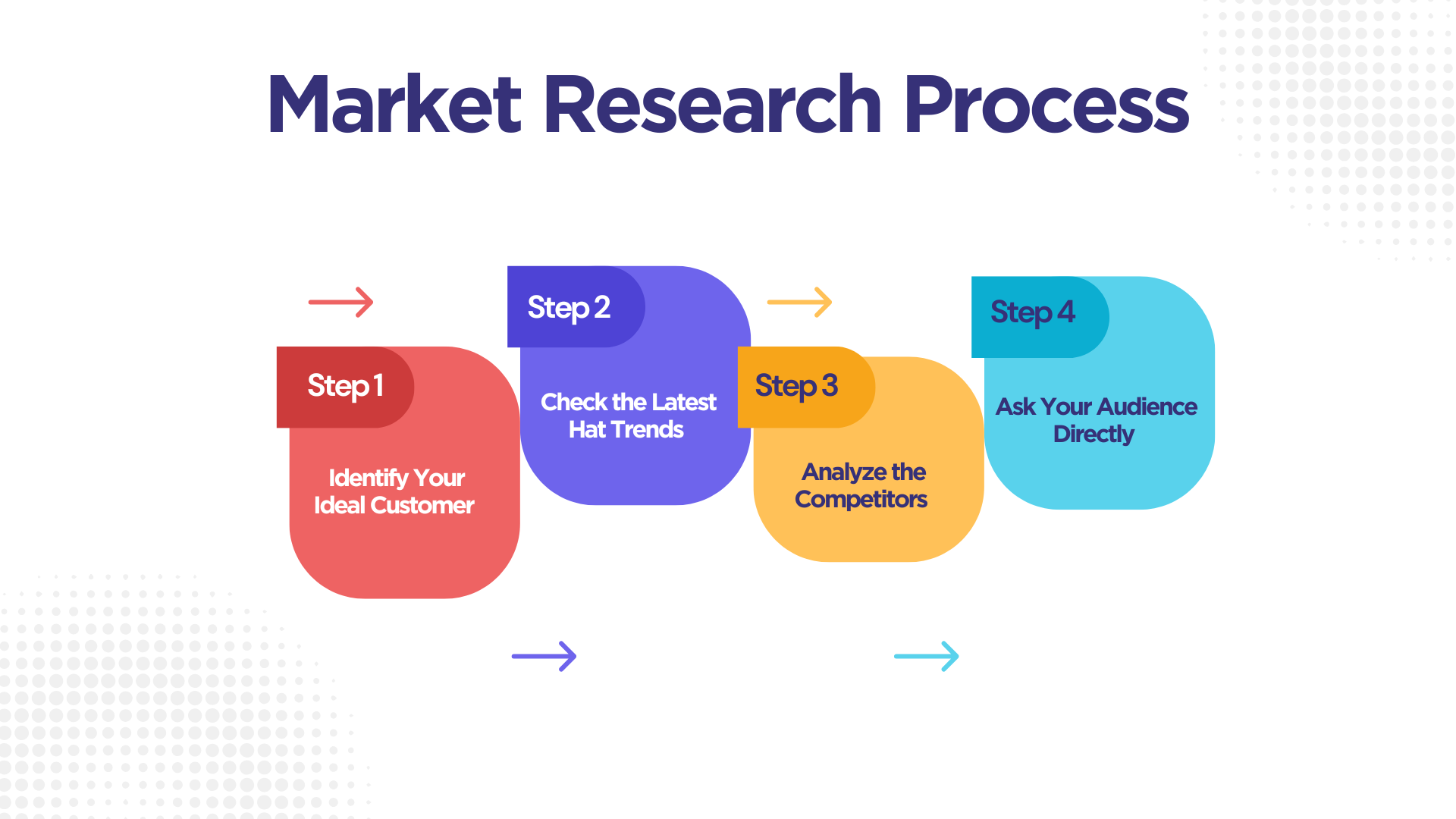
Before designing your first hat or even opening your online store, you must understand who you’re selling to and what they want. This step, known as market research, is one of the most crucial aspects of establishing a successful business.
This research will help you understand who your potential customers are, see which hats are trending, and pinpoint what’s missing in the market (so you can offer it).
Here is how you can research the market –
- Identify Your Ideal Customer
Knowing who your potential customer is can help you target your marketing efforts and tailor your designs better. You can do this by finding out their age group, interests, where they spend time online, and what problems they might have that your offering can solve.
- Check the Latest Hat Trends
With so many types of hats available, you need to find out which ones are trending to cater to your audience.
Stay updated on what’s popular by using Google Trends to see what people are searching for, social media to check hashtags like #hatstyles, #streetwear, or #summerhats, or explore Pinterest for trending colors, patterns, and designs.
- Analyze the Competitors
Check out other successful hat brands to find their best sellers, how much their products cost, how they brand their products, and what their customers are saying about them.
- Ask Your Audience Directly
If you already have followers (even a small group) on other platforms like Facebook, you can conduct social media polls or surveys using Google Forms and other free tools to find out what types of hats they prefer.
Step 2: Find Your Niche and Unique Selling Proposition (USP)
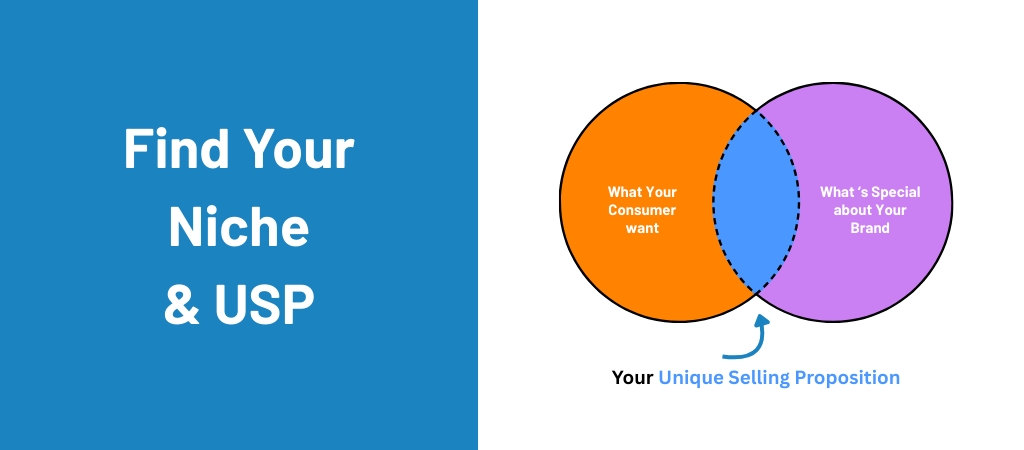
The market is oversaturated with generic hats that just about anyone can use, but to stand out, you need to offer hats that connect to a particular group. A niche or a USP is basically just that – a specific trait that makes your product unique.
Pick a niche by focusing on a specific segment of the market, and cater directly to your ideal customer’s tastes and preferences. To figure out your USP, ask yourself –
- Why would someone choose my product instead of my competitor’s?
- What’s special about my brand or products?
Examples of Hat Niches
- Pet lovers (hats with dog or cat designs)
- Outdoor adventurers (waterproof hiking hats)
- Vintage fashion fans (90s retro-style bucket hats)
- Eco-conscious shoppers (hats made from recycled materials)
- Sports team supporters (custom baseball caps)
Step 3: Develop A Solid Business Plan
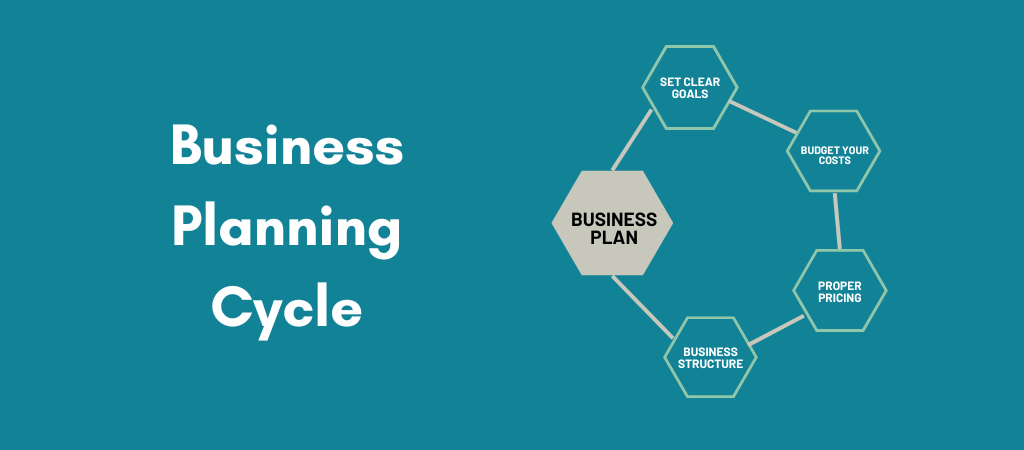
Now that you understand your market, audience, niche, and what sets you apart, it’s time to plan your business and its goals. A business plan is like a map; it shows you where you’re going and how to get there without getting lost.
It doesn’t have to be complicated or include fancy business jargon, it just needs to be clear and helpful for you. Here’s what to include in your business plan –
Set Clear Goals
You must maintain motivation and focus, especially during your first year. So, start by writing down some clear goals you have for your business. Goals for hat businesses can include selling 500+ hats, introducing three specific collections, getting 5,000 followers on Instagram, etc.
Budget Your Costs
Starting any business, even ones that only exist online, costs significant upfront investments. So, you need to create a clear budget for –
- Designing hats (tools, freelancers)
- Making hats (production, samples)
- Setting up your website (hosting fees, domain name)
- Marketing (ads, influencer collaborations)
- Packaging and shipping costs
Correctly Price Your Hats
Crafting the right price for your hats involves a straightforward calculation: simply add your production cost per hat to your desired profit margin to arrive at your initial selling price.
For instance, if each hat costs you $12 to make and you aim for an $8 profit, your selling price would be $20. However, it’s also wise to take a look at the market and see how similar hats are priced to keep your offering both fair to your customers and competitive within the market.
Choose Your Business Structure
Before you continue with your business model, you need to register your business. You can choose to be the sole proprietor, opt for a Limited Liability Company (LLC), or just establish a partnership.
Step 4: Select Your Business Model
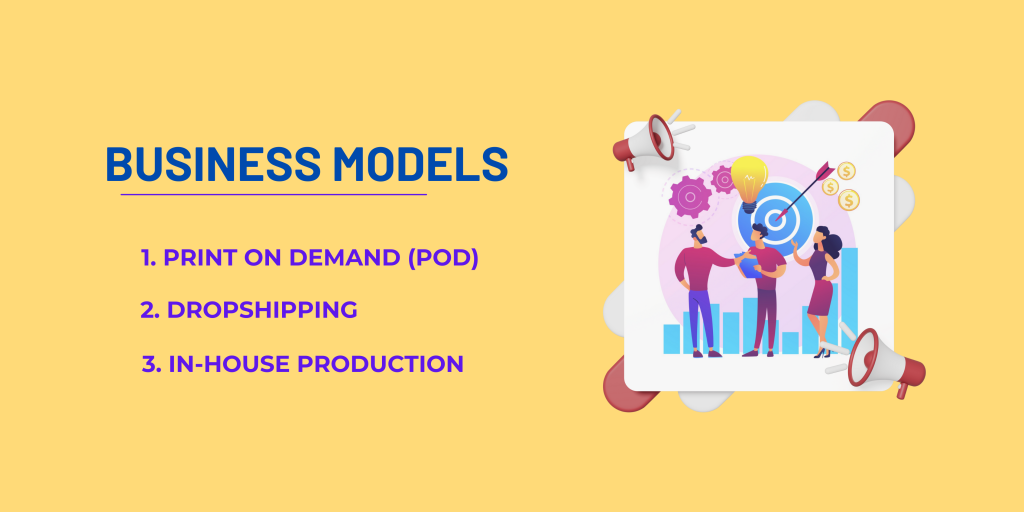
Before you start selling, you must decide how to run your business. Your business model is the way you create and deliver your products to customers. Below, we’ll show three types of models fit for a hat or apparel business –
1. Print on Demand (POD)
This model is perfect for beginners who want an easy, low-risk setup. You can start your business without a physical inventory. Just upload your hat designs to platforms like Printful, Printify, or Gelato, and the company will print the hat and ship it directly to the customer on your behalf.
Pros of POD
- Very low upfront cost
- No need to manage inventory
- Easy to scale as you grow
- Focus more on design and marketing.
Cons of POD
- Smaller profit margins compared to making in bulk
- Less control over shipping times.
2. Dropshipping
This model is best for sellers who want an easy inventory handling and are okay with limited control. Dropshipping lets you sell hats from a supplier’s catalogue, and the supplier ships the hats directly to your customers.
Pros of Dropshipping
- No inventory to store
- Easy to start with lots of suppliers available
- Offer a wide variety of hats
Cons of Dropshipping
- It is harder to create customer-branded products
- Less control over quality and shipping speed.
3. In-house Production
If you have a flexible budget and want complete control over your inventory, in-house production may be the right model for you.
Pros of In-house Production
- Get full control over quality, design, and timelines
- No waiting for external suppliers
- Higher profit margins with no middleman costs
Cons of In-house Production
- High upfront costs for equipment, materials, and labor
- Hard to scale quickly without major investment
- Need expertise in manufacturing
Step 5: Source and Develop the Product
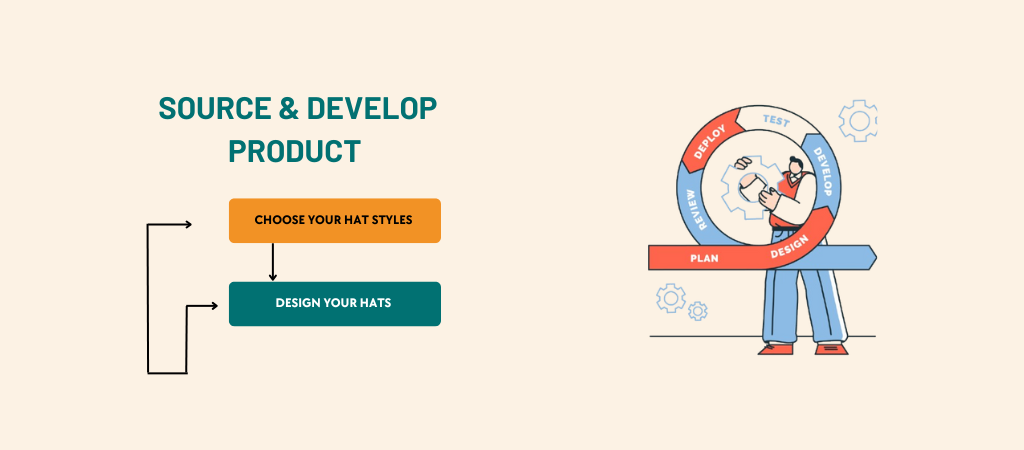
Now it’s time to turn your hat ideas into real products. Since your hats will represent your brand, make sure you focus on quality, style, and customer satisfaction.
Choose Your Hat Styles
You don’t need to offer every type of hat from the get-go. Start with one or two styles that align with your brand and audience. Some popular options include baseball caps, snapbacks, trucker hats, beanies, visors, and more.
Design Your Hats
There are a few ways you can create designs from your ideas. You can use DIY design tools like Canva or Adobe Illustrator. Hire a freelancer on Fiverr or Upwork for professional designs, or just use print-on-demand services like the ones mentioned above.
Step 6: Develop a Solid Brand
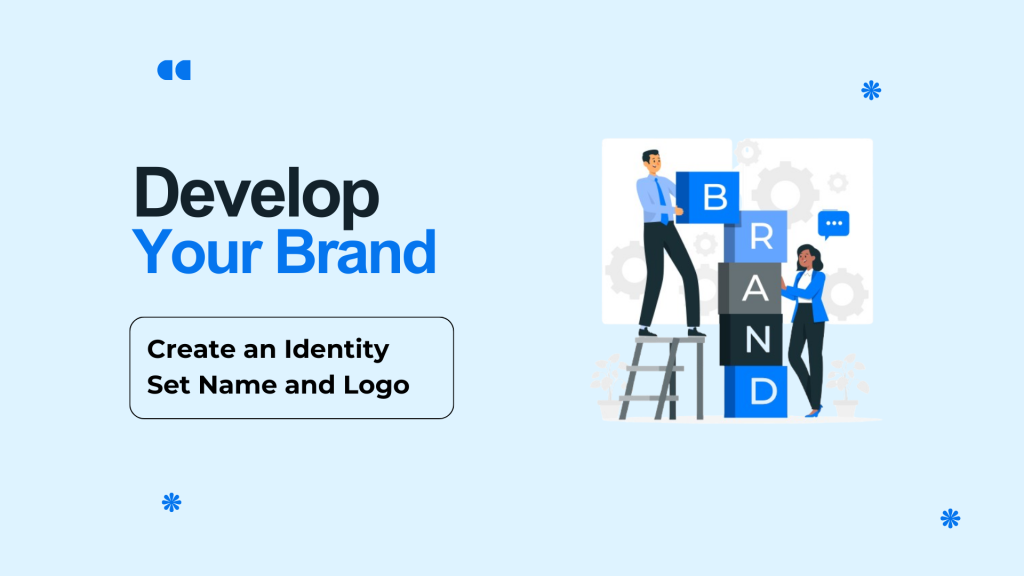
Your brand is the personality of your business. Having a solid brand helps you stand out from competitors and build trust with customers.
Create an Identity
Start by defining your core values – are you more inclined to urban style, outdoor adventure, or sustainable fashion? Also, do you want to evoke confidence, nostalgia, or a sense of belonging? Make sure you tell a story with your brand, so customers can connect to your message.
Set Name and Logo
Set a memorable name and logo, and aim for something distinctive yet simple. Always verify domain and social media availability before committing.
Use free design tools or hire freelancers to create a logo that reflects your brand.
Step 7: Build Your Online Hat Store
Now that everything is in place, it’s time to set up your store online. With so many businesses being run entirely online, you won’t need a physical store to get started. Below, we will show you what you need to build your online store.
Choose an Ecommerce Platform
There are various types of platforms that will help you start your ecommerce business. We will only be covering the best ecommerce platforms for small businesses with limited budgets.
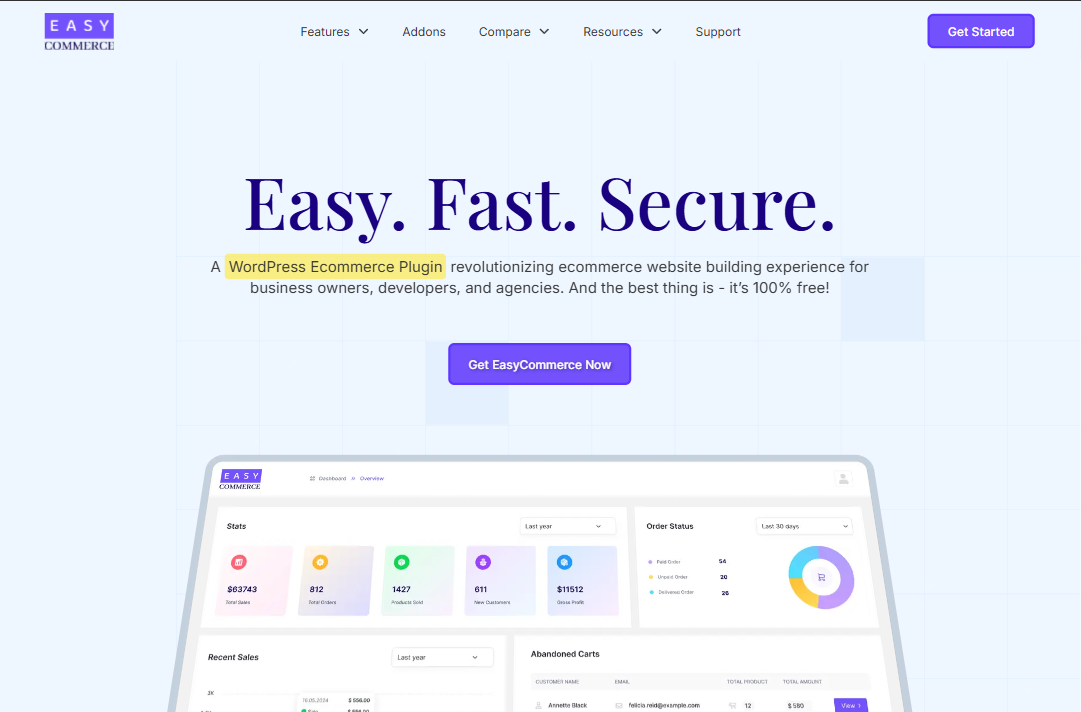
EasyCommerce is our top pick because it’s free and has everything you need to start an online store on WordPress. It’s extremely easy to use, even for those new to this. The platform is fast and user-friendly, so you can easily manage your products, orders, and payments.
It also lets you sell both physical and digital products, so if you want to sell your hat designs as well as your hats, EasyCommerce is a great choice.
Good things about EasyCommerce
- Your website will remain fast, even with a large number of products and visitors.
- You’ll get a simple dashboard with vital information, such as sales and abandoned carts.
- You can set alerts for low stock.
- It works with multiple payment gateways and doesn’t charge extra fees.
- You can easily design your product pages with ready-made templates.
- You can list as many products as you want.
- Migrating your store from another platform is easy with add-ons.
Things to keep in mind
- It only works with WordPress.
- It’s new, so some features are still being worked on.
Price
The core plugin is free. You may need to pay for a domain name, hosting.

Shopify is an easy-to-use and intuitive platform for selling products online. With most essential ecommerce features built in, you can create a great-looking hat store without any prior technical experience.
You will also get professional-looking templates, so you can quickly design your site to reflect your brand. And with intuitive tools for product management, marketing, shipping, and more, managing your store will be easy.
Good things about Shopify
- It’s super easy to use.
- Lots of stunning, ready-made template options.
- Simple to add and manage products.
- They have a dedicated app store to integrate with your site.
- Your store can grow and scale in tandem with your business.
Things to keep in mind
- Designs are restrictive with their template-based structure.
- You will have to pay extra for transaction fees (if you’re not subscribing to Shopify Payments).
Pricing
Plans start at $29/month, which is billed annually.
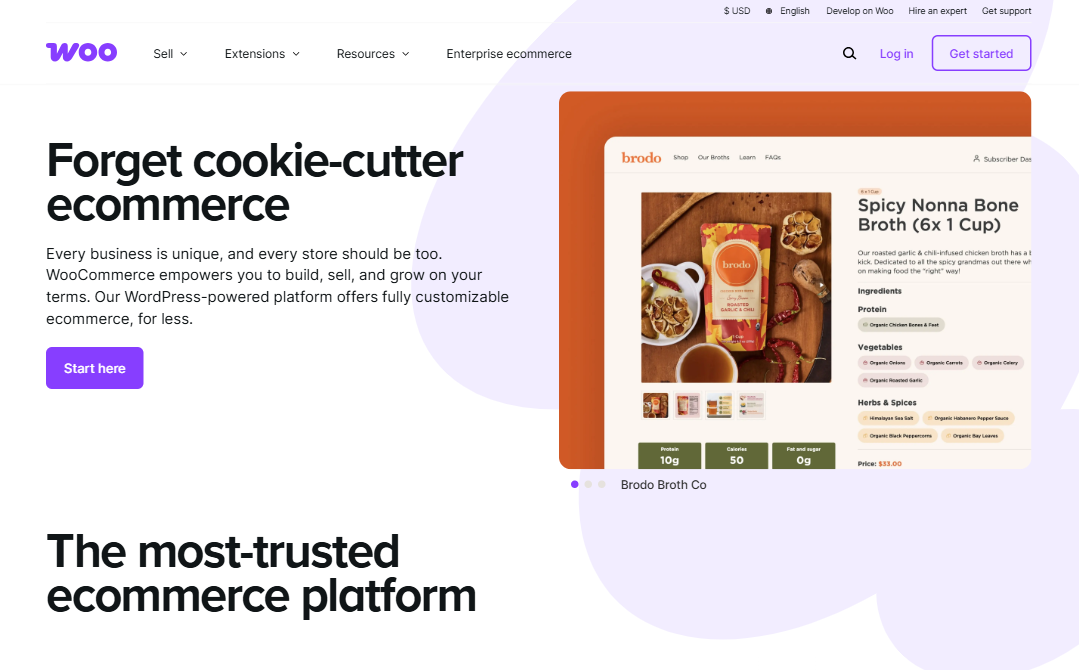
WooCommerce is a free plugin that you can add to your WordPress website to transform it into an online store. You can change almost anything you want about it. You own your store completely (no monthly payments like Shopify), but you are responsible for managing tasks such as website hosting and security yourself.
Good things about WooCommerce
- It’s free to start.
- You can customize almost everything.
- You own your store completely.
- A huge library of add-ons and tools is available.
Things to keep in mind
- You need a WordPress website.
- You have to manage your hosting and security.
- Setting it up requires a technical learning curve
Price
The core plugin is free, but you need to pay for hosting, a domain, and premium plugins.
Pro Tips to Build Your Online Hat Store
If you’ve already settled on an ecommerce platform, here are some tips on what to include when building your online hat store –
- Add high-quality product photos from every angle
- Include clear and informative descriptions of your products
- Offer multiple payment options at checkout, including local gateways
- Clearly define shipping costs, returns, and refund policies
- Categorize your products based on brand and use cases.
Step 8: Promote and Market Your Store
You’ve got your hats ready, and your store is built. Now it’s time to get people to notice you! Marketing is attracting customers, building your brand, and turning visitors into buyers.
Even the best product in the world won’t sell if no one knows it exists.
Promote on Social Media
Nowadays, social media is the best and cost-effective way to promote your brand. Use Facebook, Instagram, and TikTok to post behind-the-scenes content, customer reviews, styling tips, and even new product launches and promotions.
Run Email Campaigns
Emails are a great way to update your customers about the goings-on in your store, as well as share exclusive discounts and news about new products. It helps nurture a connection to turn visitors into loyal customers.
Run Paid Ads
You can run paid ads using Google AdSense and Facebook Ads Manager. If you have an idea about your target audience, you can specifically cater your ads to them.
Optimize Your Store for SEO
You can improve your store’s visibility on search engines by adding relevant keywords to your website content and incorporating technical SEO like mobile optimization.
Wrapping Up
Launching a hat business is an exciting journey, full of creative opportunities and challenges. To figure out how to start a hat business, you need to identify who might buy your hats and what they prefer.
Remember, every major brand was once just starting out. With passion, persistence, and the right approach, your hat business can thrive!
Frequently Asked Questions (FAQs)
Q1. Is starting a hat business expensive?
Not at all! Using Print-on-Demand (POD) services, you can start your hat business for as little as $1,000-$3000. You don’t need to buy lots of inventory. You only pay when you make a sale.
Q2. What type of hats sell the best?
Baseball caps and trucker hats are the most popular.
They’re versatile, easy to customize, and loved by people of all ages.
Q3. How long does it take to launch a hat store?
If you stay focused, you can set up your online hat store in just 2 to 4 weeks.
This includes designing your hats, building your website, and preparing your marketing plan.
Q4. Should I use Shopify or WooCommerce?
Shopify is ideal for a quick and easy setup, requiring minimal technical expertise.
EasyCommerce is a better option if you already know WordPress and want more customisation options.
Both can help you build a successful store. It depends on your style.
Q5. How can I make my hat brand stand out?
- Pick a niche (like eco-friendly hats or embroidered designs)
- Tell a great brand story
- Offer unique designs and excellent customer service

